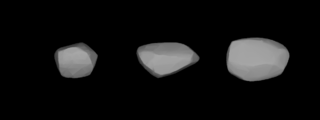
92 Undina is a large main belt asteroid. The asteroid was discovered by Christian Peters on 7 July 1867 from the Hamilton College Observatory. It is named for the eponymous heroine of Undine, a popular novella by Friedrich de la Motte Fouqué.

118 Peitho is a main-belt asteroid. It is probably an S-type asteroid, suggesting a siliceous mineralogy. It was discovered by R. Luther on March 15, 1872, and named after one of the two Peithos in Greek mythology. There have been two observed Peithoan occultations of a dim star: one was in 2000 and the other in 2003.
507 Laodica is a minor planet orbiting the Sun.

572 Rebekka is a minor planet orbiting the Sun, which was discovered on September 19, 1905, by a German astronomer Paul Götz in Heidelberg. It was named after a young lady from Heidelberg, and may have been inspired by the asteroid's provisional designation 1905 RB.
585 Bilkis is a minor planet, specifically an asteroid orbiting in the asteroid belt. It was discovered by German astronomer August Kopff in 1906 February and was given the Koran name for the Queen of Sheba. Photometric observations at the Palmer Divide Observatory in Colorado Springs, Colorado in 2006–7 were used to build a light curve for this object. The asteroid displayed a rotation period of 8.5742 ± 0.0005 hours and a brightness variation of 0.40 ± 0.02 in magnitude.
586 Thekla is a minor planet orbiting the Sun. It was named after Saint Thecla of the first century. The name may have been inspired by the asteroid's provisional designation 1906 TC.

605 Juvisia is a minor planet, specifically an asteroid orbiting in the asteroid belt that was discovered 27 August 1906 in Heidelberg by German astronomer Max Wolf. It was named after the commune Juvisy-sur-Orge, France, where French astronomer Camille Flammarion had his observatory.
607 Jenny is a minor planet, specifically an asteroid orbiting in the asteroid belt that was discovered by German astronomer August Kopff on September 18, 1906.
616 Elly is a minor planet orbiting the Sun. It is a member of the Maria family of asteroids.
620 Drakonia is a minor planet, specifically an asteroid orbiting in the asteroid belt. It was discovered October 26, 1906, in Taunton, Massachusetts, by American astronomer Joel Hastings Metcalf and given the preliminary designation 1906 WE. It may have been named for Drake University.
687 Tinette is a minor planet, specifically an asteroid orbiting primarily in the asteroid belt. It was discovered by Austrian astronomer Johann Palisa on 16 August 1909 from Vienna and was given the preliminary designation 1909 HG.

699 Hela is a Mars crossing asteroid. It was discovered on 5 June 1910 at Heidelberg by German astronomer Joseph Helffrich, and may have been named after Hel, the Norse ruler of the underworld. This asteroid is orbiting the Sun at a distance of 2.61 AU with a period of 4.22 years and an eccentricity of 0.41. The orbital plane is inclined at an angle of 15.3° to the plane of the ecliptic.

708 Raphaela is a minor planet orbiting the Sun.
840 Zenobia is a minor planet orbiting the Sun. It was discovered by German astronomer Max Wolf at Heidelberg on September 25, 1916. The origin of the name is uncertain, but it may be named after the Slavic god of the hunt.
860 Ursina is a minor planet orbiting the Sun that was discovered in 1917 by German astronomer Max Wolf. The origin of the name is unknown.
829 Academia is a minor planet orbiting the Sun. The asteroid is roughly 44 km in diameter and has a low albedo. Photometric measurements of the asteroid made in 2005 at the Palmer Divide Observatory showed a light curve with a period of 7.891 ± 0.005 hours and a brightness variation of 0.44 ± 0.02 in magnitude.
947 Monterosa is a minor planet orbiting the Sun.
9069 Hovland, provisional designation 1993 OV, is a stony binary Hungaria asteroid from the inner regions of the asteroid belt, approximately 3 kilometers in diameter.
9165 Raup, provisional designation 1987 SJ3, is a stony Hungaria asteroid and exceptionally slow rotator from the inner regions of the asteroid belt, approximately 4.7 kilometers in diameter.
6250 Saekohayashi, provisional designation 1991 VX1, is a bright Hungaria asteroid and relatively slow rotator from the inner regions of the asteroid belt, approximately 3.7 kilometers in diameter. It was discovered on 2 November 1991, by American astronomer Eleanor Helin at Palomar Observatory in California, and later named after Japanese astronomer Saeko Hayashi.






